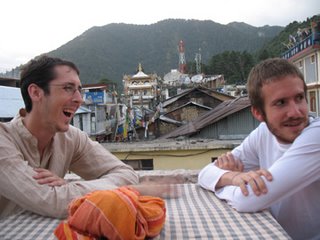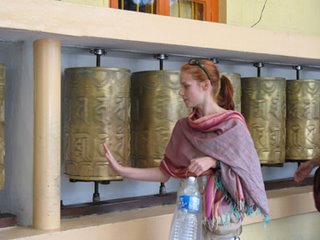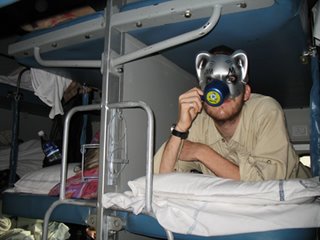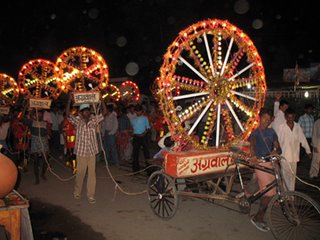Friday, June 09, 2006
Cooler Daze in India

We have made it to McLeod Ganj, a Tibetan village just north of Dharamsala. The weather is cooler, the streets are safer and the flavor and tone of the region is very laid back and relaxing. There are more westerners here than in the other places we’ve visited.
In the past few days, we’ve taken quite a few trail walks in these hills, most notably to the Tibetan Children’s Village and to this massive waterfall. The source of the waterfall is the snow runoff from the Himalayan mountains a few hundred miles away. After climbing to the waterfall site, a few of us took the plunge and, for the first time in a month, got to swim.
Independent projects are underway these days. Ashley and Dani have met with a woman who conducts research on Tibetan nuns; JT has met a film director at the Tibetan Institute of Performing Arts; Nabeel has approached a doctor of Tibetan medicine and has a few capsules that he hopes to bring back home to analyze under a microscope and spectrometer; Bob has met with a Tibetan metal smith and continues with Aleta to craft collages of scraps and bits of Indian street life; James and Geoff will soon spend a few days in solitude on a meditation retreat.
of Tibetan medicine and has a few capsules that he hopes to bring back home to analyze under a microscope and spectrometer; Bob has met with a Tibetan metal smith and continues with Aleta to craft collages of scraps and bits of Indian street life; James and Geoff will soon spend a few days in solitude on a meditation retreat.
It is interesting to be in McCleod Ganj. This is the home of the Dalai Lama, and many, many Tibetans who have fled China (which claims to view Tibet as part of China). The precariousness of the terrain seems to inform, or illustrate in some way, the careful balance required of surviving on the edge of a precipice. There is an unsettled feeling here in spite of the c ozy, homey spaces the Tibetans have managed to carve out for themselves. They are refugees, but have managed to create institutions and organizations that will ensure that their culture and traditions will continue.
ozy, homey spaces the Tibetans have managed to carve out for themselves. They are refugees, but have managed to create institutions and organizations that will ensure that their culture and traditions will continue.
This is the final blog… as far as I can tell. I leave tomorrow morning for Delhi, and then I’m off back home to the United States. I may post a line or two of reflection when I get a chance.
The rest of the group will remain in Dharamsala for a few more days before they, too, leave India for the places they call home.
Thank you for reading and for your message
reading and for your message s of support of our endeavors here in India.
s of support of our endeavors here in India.
Tuesday, June 06, 2006
Commerce and Communion in India...
http://www.reflector.com/featr/content/features/stories/2006/06/04/india.html
Monday, June 05, 2006

Amid the hundreds of robed monks and Buddhist tourists who come to the small Indian village of Bodh Gaya, there is a roadside shop that sells masks and chains. Key chains, that is. The masks are hyper bright and eerie-scary. It’s harder to say which is most scary: There’s Tweety Bird and Batman and a Donald Duck masks that are slightly off in their look and coloring, as though a warning signal has gone off because the masks before you do not jibe with the icon ingrained your mind. There are also silvery cat masks; a clown too pink to be pleasant, like everything you ever feared in a circus has culminated in this one mask. There are devil-masks, complete with horns, a few skeletons, and a lone mask of Hanuman (the Hindu monkey god). We felt oddly ill at ease looking at them, but like so many car wrecks, we had to stop.
And of course, for 20 rupees apiece, Nathan and I could not resist buying a few to share with our loved ones back home. A few days later, on the train from Gaya to Delhi, he tried to spook out our train attendant by taking his morning tea with the cat mask. The gesture elicited no response.

Bodh Gaya has been a great place for resting for us. In our own time, and as part of a group, each of us has made it to the Mahabodhi Temple, the site of the Buddha’s enlightenment. Of course, when he was actually here, there was no stories high monumnent, no crystal-embedded throne, no little stupas and pillars of worship dotting the areas. At the beginning, there was one simple tree and one man. The current bodhi tree at the site is a descendent of the original bodhi tree, according to the guidebooks.
One evening, James, Derek and I went to visit the temple after dark. It was a nice evening, and the moths and all light-loving insects (so, all of them) were out in full-force basking in the spotlights that illuminated the temple and the tree. We walked along the temple’s outer path, and then sat outside in front of the great bodhi tree. The tree is protected, behind ba
 rs, so to speak, to protect it. Two of its many large limbs are held up with metal supports and people offer it water daily. On occasion, the tree will drop a few leaves. From dawn to dark, people come to sit around the tree, or inside the temple, or on any one of the little platforms and cement shines that surround it. On this particular evening, as we sat under the tree, avoiding the insects that would haphazardly bombard us (but not bite or sting) from time to time, the three of us were able to watch a monk become ordained. It was a small ceremony, just a few family members were present and three monks in dark red robes. The man, whose head was already shaved close, was dressed at first in street clothes, a Tshirt and pants. At one point, he kneeled and offered the monks a beautifully folded cylinder of cloth. It occurred to me that these were his robes, and would soon become his sole possession. Monks of other orders (you can tell by the color and style of their robes), stood or sat around the small group. A few of them took photos and smiled with these giddy grins. There was one who clasped his hands, rejoicing at the site. At the end, his mother offered him his alms bowl, and many of us around the temple, gave small offerings of money, incense and food. The guard came by and said it was time to close the temple.
rs, so to speak, to protect it. Two of its many large limbs are held up with metal supports and people offer it water daily. On occasion, the tree will drop a few leaves. From dawn to dark, people come to sit around the tree, or inside the temple, or on any one of the little platforms and cement shines that surround it. On this particular evening, as we sat under the tree, avoiding the insects that would haphazardly bombard us (but not bite or sting) from time to time, the three of us were able to watch a monk become ordained. It was a small ceremony, just a few family members were present and three monks in dark red robes. The man, whose head was already shaved close, was dressed at first in street clothes, a Tshirt and pants. At one point, he kneeled and offered the monks a beautifully folded cylinder of cloth. It occurred to me that these were his robes, and would soon become his sole possession. Monks of other orders (you can tell by the color and style of their robes), stood or sat around the small group. A few of them took photos and smiled with these giddy grins. There was one who clasped his hands, rejoicing at the site. At the end, his mother offered him his alms bowl, and many of us around the temple, gave small offerings of money, incense and food. The guard came by and said it was time to close the temple.We left the temple and walked back to our hotel and heard loud music. We didn’t think too much of it, but when we arrived in the lobby, we found that JT and Jamie and Bret, Josh, Dani, Nabeel, Geoff, and Nathan
 were about to go where the music was. It turned out it was the beginning of a wedding, called the Bharat. The Bharat is a procession the groom’s family makes to the bride’s village. This particular bharat had the feel of a dance party parade. Leading the procession was a rattling generator, which fueled the cascade of lights and music that flooded the streets. Men balanced wheels of light and tinsel on their heads; there were others in red uniforms and band caps with trumpets and horns and drums at the ready in their hands. A Public Address system attached to a silvery cart was responsible for the musical broadcast. The parade had just started, and there was lots of dancing. Many of the boys in our group got pulled into the fray and danced in celebration of a couple they were never going to meet. They eventually filtered out of the craziness, one by one, and the parade went on its way, through the hard-packed dirt streets of Bodh Gaya, to a bride and her family.
were about to go where the music was. It turned out it was the beginning of a wedding, called the Bharat. The Bharat is a procession the groom’s family makes to the bride’s village. This particular bharat had the feel of a dance party parade. Leading the procession was a rattling generator, which fueled the cascade of lights and music that flooded the streets. Men balanced wheels of light and tinsel on their heads; there were others in red uniforms and band caps with trumpets and horns and drums at the ready in their hands. A Public Address system attached to a silvery cart was responsible for the musical broadcast. The parade had just started, and there was lots of dancing. Many of the boys in our group got pulled into the fray and danced in celebration of a couple they were never going to meet. They eventually filtered out of the craziness, one by one, and the parade went on its way, through the hard-packed dirt streets of Bodh Gaya, to a bride and her family.